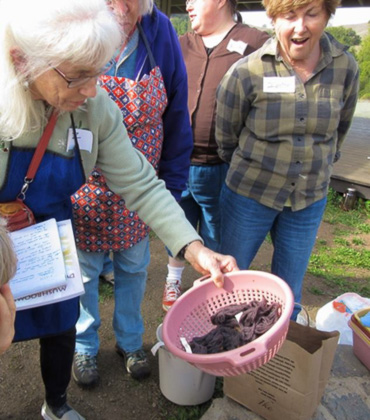 |
The
IMDI was created by Miriam C. Rice in 1985 to encourage the use
of Fungal Pigments; to further research on their extraction and
employment; to encourage research and cultivation of dye fungi;
to financially assist artists and researchers to participate in
the international symposia and exhibitions. |
|---|
WORKSHOPS |
Sonoma County
Mushroom Dye Workshop at Pepperwood Preserve
with Dorothy
and Myra Beebee
|
Samples of some of the dyes produced in the Sonoma County Mushroom Dye Workshop, at Pepperwood Preserve, Santa Rosa, California (Photo by Therese Shere) |
|---|
 |
The view to dye for, from Bechtel House at Pepperwood Preserve on November 16, 2014 as we explored some of the mushroom dyes to be found in Sonoma County, CA. Photo by Myra Beebee |
|---|
In the morning we dyed with the following fresh mushrooms found in drought- parched Sonoma County: Phaeolus schweinitzii Pisolithus azhirus and Gymnopilus sp. for a range of yellow, gold, rust, dk. green and brown earth tones. In the afternoon we played with the challenging Omphalotus (photo inset) and Cortinarius dyes, adjusting the pH using white vinegar or washing soda as needed to enhance, brighten and change the hues on our wool samples. These modifications gave a range of "sunset" colors of orange, apricot, pink, lavender, violet and an incredible dk green! (photo by Therese Shere) |
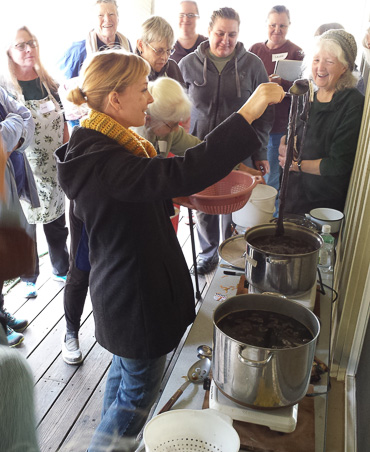 |
|---|
Samples of wool yarn dyed with Gymnopilus sp. growing on woodchips from Monterey Pine in Cotati, CA Wool was premordanted with alum (for gold dye) and iron (for olive green dye) and all simmered together in the same dye bath. (Photo of wool samples by Stacy Mora) (Photo of mushrooms by Patrick Hamilton) |
 |
|---|
Phaeolus schweinitzii |
(photo by Therese Shere) |
|---|
Pisolithus azhirus - "Dyers Puffball" very common in the fields and roadsides of Sonoma County late summer/Fall |
The 3 red gilled Cortinarius smithii (formerly known as Dermocybe phoenicia var. occidentalis) were found at Salt Point (photo of 3 Cortinarius by Stacy Mora)
|
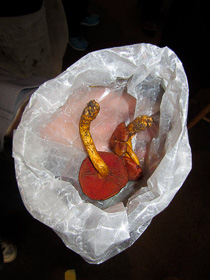 |
|---|
|
A combination of dried and frozen Omphalotus olivascens ("Jack O'Lantern") fungi produced lavender and purple dyes on wool when the acidity of the dyebath was lowered to pH 4 using white vinegar, but in a separate pot, dye turned a deep forest green on iron mordanted wool when the bath was changed toward alkaline (pH9) by adding washing soda. (Drawing by D. Beebee) |
|---|---|
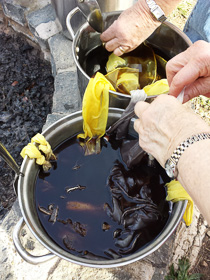 |
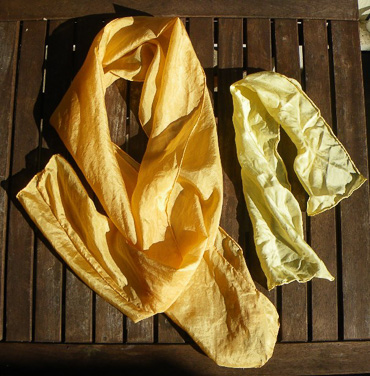 |
|---|---|
Some creative use of the silk scarves in the left over Phaeolus and Omphalotus dyepots! |
One dyer took home some left over orange Cortinarius dyes, and dyed the silk scarf (on the left). The scarf on the right was dyed in class with Phaeolus schweinitzii. (Photo by Doerte Mann) |
Genus = Beebee
Species = Myra & Dorothy
(photo of specimens by Stacy Mora)
Ancient dyer's ritual of "swirling the yarn" captured by Izetta Feeny
Mushrooms
for Color Website designed by Dorothy Beebee © 2014
All rights reserved. (This IMDI Website page was updated (with the help
of Martin Beebee!) November 27, 2014)





